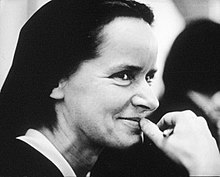Next month we'll be opening a new exhibit on silkscreen in Horgan and Graphics Galleries, continuing my annual tradition of using RMAC's fantastic works on paper collection to explore specific printmaking techniques. In anticipation of that show, today we'll take a look at one of the artists in our collection: Corita Kent (1918-1986).
 |
| Image courtesy of https://en.wikipedia.org/wiki/Corita_Kent |
Born is Iowa as Frances Elizabeth Kent, Corita entered the Sisters of the Immaculate Heart of Mary in 1936, taking on the name Mary Corita Kent. She took art classes at Otis (today the Otis College of Art and Design), and the Chouinard Art Institute (now part of the California Institute of Arts), earning her BA from Immaculate Heart College in 1941. In 1951, she earned her MA in art history from the University of Southern California. As chair of the art department at Immaculate Heart College, Kent became an influential teacher, with her classes attracting the likes of
Buckminster Fuller,
Charles and Ray Eames, and
Alfred Hitchcock.
Kent had already begun exploring the art of silkscreen during the 50s and 60s, but her work was largely figurative at this time, drawing inspiration from traditional religious subjects. The RMAC has one of these early prints,
The Visitation, which depicts the visit that occurred between Mary and Anne while pregnant with John the Baptist and Jesus, respectively.
 |
| Corita Kent, The Visitation, ca. 1950s-1960s, color serigraph on paper. Image courtesy of the Roswell Museum and Art Center. |
The seminal moment for her printmaking career occurred in 1962, when she saw an exhibit of paintings by
Andy Warhol. Inspired by his use of popular culture, Kent began appropriating text for her own work. As a Catholic nun, she created work that was both religious and political in nature, using everything from Biblical verses to advertisements and even Beatles lyrics to comment on the Vietnam War, the Civil Rights movement, and the progressive policies of Vatican II. The combination of bold text and bright colors made her a veritable style within the Pop Art world, and she exhibited her work internationally. One wouldn't expect a Catholic nun to be at the forefront of Pop Art, but she understood this art form's ability to loudly and clearly communicate important messages, and appropriated its aesthetics to her own creative ends.
 |
| Christ Drew in the Sand, 1962, color screenprint on wove paper. Image courtesy of http://portlandartmuseum.us/mwebcgi/mweb.exe?request=record;id=21835;type=101 |
 |
| The Better to Go With, 1967, color serigraph on paper. Image courtesy of http://www.warhol.org/CoritaKent/ |
 |
| For Emergency Use Soft Shoulder, 1966, color serigraph on paper. Image courtesy of http://www.warhol.org/CoritaKent/ |
In 1968, Corita Kent relocated from Los Angeles to Boston. Frustrated with the delayed fulfillment of Vatican II and the increasingly tense political and religious climate of the era, Kent officially left the Sisters of the Immaculate Heart to assume a secular life. Her art became more introspective, taking on more personal topics such as illness, but she considered to produce significant works, including her 1971 Boston Gas Tank.
 |
| Boston Gas Tank, 1971. Image courtesy of https://www.bostonglobe.com/arts/2015/08/27/corita-kent-faith-infused-pop-art-view-harvard/RIrpX4DfgHZSAjlOlBrSVK/story.html |
Kent was largely forgotten after the 60s, but thankfully there has been a renewed interest in her work.
Harvard art museums did a large-scale
exhibit of her work last year, for example, which included an extensive catalogue. The
Portland Art Museum in Oregon also has a
show of her work on view through the end of this month. Hopefully interest in her work will continue to grow, as audiences and art historians alike take greater notice in her unique interpretation of Pop Art language.
 |
| Manflowers, 1969, color serigraph on paper. Image courtesy of http://www.warhol.org/CoritaKent/ |
As far as my books go, she's definitely a printmaker you should know.
Want to learn more?
http://corita.org/
http://www.npr.org/2015/01/08/375856633/a-nun-inspired-by-warhol-the-forgotten-pop-art-of-sister-corita-kent
http://harvardmagazine.com/2015/08/corita-kent-nun-with-a-pop-art-habit







Comments
Post a Comment
Questions? Comments? Speak your mind here.